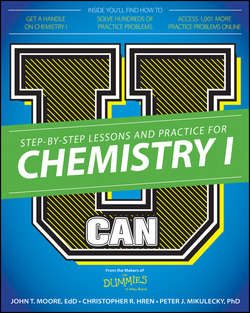Читать книгу U Can: Chemistry I For Dummies - Hren Chris - Страница 17
На сайте Литреса книга снята с продажи.
Part I
Chapter 3
Breaking Down Atoms into Their Subatomic Particles
ОглавлениеIn This Chapter
▶ Peeking inside the atom
▶ Exploring a brief history of the atom
▶ Deciphering atomic numbers and mass numbers
▶ Understanding isotopes and calculating atomic masses
▶ Checking out a chart of all elements in alphabetical order
“Big stuff is built from smaller pieces of stuff. If you keep breaking stuff down into smaller and smaller pieces, eventually you’ll reach the smallest possible bit of stuff. Let’s call that bit an atom.” This is how the Greek philosopher Democritus might have explained his budding concept of “atomism” to a buddy over a flask of Cretan wine. Like wine, the idea had legs.
For hundreds of years, scientists have operated under the idea that all matter is made up of smaller building blocks called atoms. So small, in fact, that until the invention of the electron microscope in 1931, the only way to find out anything about these tiny, mysterious particles was to design a very, very clever experiment. Chemists couldn’t exactly corner a single atom in a back alley somewhere and study it alone – they had to study the properties of whole gangs of atoms and try to guess what individual ones might be like. Through remarkable ingenuity and incredible luck, chemists now understand a great deal about the atom. After reading this chapter, so will you.
The Atom: Protons, Electrons, and Neutrons
The atom is the smallest part of matter that represents a particular element. For quite a while, the atom was thought to be the smallest part of matter that could exist. Picture an atom as a microscopic LEGO. Atoms come in a variety of shapes and sizes, and you can build larger structures out of them. Like a LEGO, an atom is extremely hard to break. In fact, so much energy is stored inside atoms that breaking them in half results in a nuclear explosion. This section examines the parts of an atom.
Breaking an atom into its parts
In the latter part of the 19th century and early part of the 20th, scientists discovered that atoms are composed of certain subatomic particles and that, no matter what the element, the same subatomic particles make up the atom. The number of the various subatomic particles is the only thing that varies. The atom is considered the smallest possible unit of an element, because after you break an atom into subatomic particles, the pieces lose the unique properties of that element.
Scientists now recognize that there are many subatomic particles (this really makes physicists salivate). But in order to be successful in chemistry, you really need to be concerned with only the three major subatomic particles:
✔ Proton: The subatomic particle that has a positive charge; it’s found in the atom’s dense central core
✔ Neutron: The subatomic particle that has no charge; like the proton, it’s found in the atom’s dense central core
✔ Electron: The subatomic particle that has a negative charge; it’s found outside the atom’s dense central core
Table 3-1 summarizes the characteristics of these three subatomic particles.
Table 3-1 The Three Major Subatomic Particles
In Table 3-1, the masses of the subatomic particles are listed in two ways: grams and amu, which stands for atomic mass units. Expressing mass in amu is much easier than using the gram equivalent.
Atomic mass units are based on something called the carbon-12 scale, a worldwide standard that’s been adopted for atomic weights. By international agreement, a carbon atom that contains 6 protons and 6 neutrons has an atomic weight of exactly 12 amu, so 1 amu is of this carbon atom. (What do carbon atoms and the number 12 have to do with anything? Just trust us.) Because the masses of protons and neutrons are almost exactly the same in grams, both protons and neutrons are said to have a mass of 1 amu. Notice that the mass of an electron is much smaller than that of either a proton or a neutron. It takes almost 2,000 electrons to equal the mass of a single proton.
Table 3-1 also shows the electrical charge associated with each subatomic particle. Matter can be electrically charged in one of two ways: positively or negatively. The proton carries one unit of positive charge, the electron carries one unit of negative charge, and the neutron has no charge; it’s neutral.
Remember: Scientists have discovered through observation that objects with like charges, whether positive or negative, repel each other, and objects with unlike charges attract each other.
The atom itself has no charge. It’s neutral, meaning the number of positive charges present is equal to the number of negative charges present. In other words, the number of protons in an atom equals the number of electrons in an atom. Sometimes, though, atoms can have differing numbers of electrons. When that occurs, they’re called ions. We cover ions in Chapter 4.
Narrowing the focus to the nucleus
The last column in Table 3-1 lists the locations of the three subatomic particles. Protons and neutrons are located in the nucleus, a dense central core in the middle of the atom. Because they’re always found in the nucleus, they’re sometimes called nuclear particles. Electrons move around the nucleus in a cloud of many different energy levels and are discussed at great length in Chapter 4.
Конец ознакомительного фрагмента. Купить книгу
